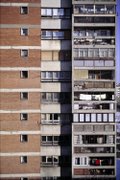What is earthquake to Singaporeans? Will it 'reach' Singapore?
In known history, Singapore has not experienced an earthquake.
Singapore is located in an area sandwiched by the Java trench in the west and south, and the Philippine plate and trench in the east.Thus Singapore is located in a seismically stable zone, free from earthquakes.Most of the shallow and bigger earthquakes are in western Sumatra and Java because of the deep subduction zones to the west-east and south-north of the Java trench. Earthquakes that occur near Singapore are usually deep focus weak earthquakes. (Refer to Figure 1).

Figure 1
However on 6th March 2007, certain parts of Singapore including the Central Business District felt tremors that were the result of a Sumatran earthquake that measured 6.6 on the Richter Scale. Buildings in the affected areas swayed, not to mention the people in them.
Responses from Singaporeans taken from local blog sites include:
'tremors only ma.. don't think need to take any cover. Unless next time an earthquake strike Singapore'.
'I didn't feel anything. Xin Li Zhuo Yong (psychological effect)…'
'…The swaying was very obvious. I felt the work station was moving and I thought it was my colleague who was pushing the work station but when it started swinging back and forth slightly it was obvious that it wasn’t the workstation that was moving but it was the building…'
'…We were doing our work on our computer when the building started shaking. So we grabbed our bags and just evacuated by the normal fire evacuation procedures. Everyone was panicking. I think one of my colleagues was crying because she had never felt such effects before. And we were all rushing out of the building. But no fire alarm was sound. We took precaution and left the building ourselves…'
Although the responses varied and the blog site could not sustain this thread after just 2 days, some questions were asked on why Singapore experienced the tremors. This is because the next one may be nearer or more intense, yet I wonder how powerful it must be to seriously affect our people, to get them to sit up, pay more attention and awareness to it.
After all, how many Singaporeans know what to do or what not to do if Singapore is to experience an earthquake? For example, do we run to open space in the event of an earthquake? (The answer is no if you are surrounded by buildings but yes if you are not) We are just being lucky as we are 'shielded' by surrounding nations; remote from earthquake zone and tsunami 'walls' sheltered up by the Indonesian Archipelago in the west and south and the Philippines in the east. Yet there were inhumane calls from the public suggesting that we stop sending rescue teams to help these victims.
However, we seem to have some evidence that along the subduction zone of the coast of Sumatra do happen in phases. In the early nineteenth century there were a number of earthquakes in relatively quick succession and we are maybe entering a phase where we have a series of earthquakes where one earthquake triggers another one further along the fault line.
Sometimes when a large earthquake occurs on parts of the fault line, the stresses are transferred further up the fault line and that may then lead to a second earthquake. We saw this happening after the original tsunami earthquake in 2004. About three months later, there was a very strong earthquake a little bit further south.
'So what?' Some might ask but the issue is that mankind do not know enough of earthquakes such as predicting the next one. Moreover, not all the factors on how the magnitude of the earthquake itself affects the felt effect on earth's surface are known.
Of course, what we do know is that when two earthquakes have the same magnitude, the deeper earthquake will have less felt effects than the shallow one. However, there is another factor which is very important but under appreciated. It is the intensity of the felt effects which is the nature of the immediate sub strata of the place or building where that earthquake is felt.
In general, a solid rock will have less shaking potentially then an area built on unconsolidated material.
This is the potential danger where almost twenty percent of Singapore’s surface area is reclaimed land. Scores of buildings that include houses, factories and hotels are located there. In the event of an earthquake, buildings will be shaken up more violently as compared to those on non-reclaimed land, which is solid and will not be liquefied by the shake.
Worse, as seen from Figure 2, Singapore is an SIA (not the airline itself, but sedimentary rocks in the Jurong formation, igneous rocks in the central and old alluvium in the east). Hence, unconsolidated sediments, which are sediments which have accumulated in buried river channels, are more likely to amplify the seismic waves as they move through them. And we find these kinds of sediments in the Central Business District, in areas to the east of Singapore and along some of the main valleys. Not to mention the softer sedimentary rocks found in the Jurong formation.
Now, if an intraplate earthquake strikes Singapore (Intraplate earthquakes occur in the middle of presumably stable tectonic plates which scientists currently do not understand the cause of this rare hazard), I am not so sure how Singapore will take to it.

Figure 2
For interest sake, a quick summary on the geology of Singapore as taught by Mr Kenneth Lim from NIE:
Singapore rides on the Eurasian plate, and this is less dense than the Indo-Australian plate which is converging against it. The great heat and pressure caused results in part of the Indo-Australian plate margin melting, releasing magma which is forced up towards the crust.
Very near the destructive boundary, the magma has enough energy to melt its way right through the Earth's crust, till it emerges as the volcanic islands of Java and Sumatra. Further away (about 400 kilometres) from the convergence zone, where Singapore presently is, the magma had lost most of its energy by the time it got near the surface because it had started from very deep within the mantle.
As a result, the magma was unable to melt its way completely through the crust and instead cooled and solidified midway. That is, the magma was intruded into the crust. The crust bulged up, forming what we now know as Bukit Timah hill. So now we know why Singapore will never experience any volcanic activity, at least in our lifetime, simply because we are too far away from all the action.
There is another main group of rocks which were being formed at around this time. Continued uplift of the batholiths beneath Peninsula Malaysia mountain range (Refer to figure 3) increased the potential energy of the overlying rocks. Their rate of erosion thus increased, and the eroded material was deposited in shallow freshwater and coastal basins. Over the years, they were compressed into sedimentary rocks called sandstones and mudstones, and in Singapore, they are termed the Jurong Formation.

Figure 3
The last main group of rocks we come across is known as the Old Alluvium (shown in peach in the east of figure 2).
The Old Alluvium consists of sand, pebbles and gravel. The average thickness of the Old Alluvium is generally believed to be about fifty metres. The deposits are believed to have been eroded from granitic rocks from south Johor. It was deposited when sea level in this part of the world fell due to global cooling.
As sea level began to rise back to its present day level, the Straits of Johor were flooded and Singapore became an island. Even today, the Straits east of the Causeway are about twelve metres deep, while some parts of that west of the Causeway are as shallow as five metres!)
Earthquakes have also been responsible for another kind of natural disaster, Tsunamis. The 2004 Indian Ocean Earthquake had its epicentre in the west coast of Sumatra. It triggered a series of devastating tsunamis that killed large numbers of people across South and South East Asia. During that period, there was a theory put forward that at some point Singapore could be affected by a tsunami in view of the shifting tectonic plates.
Now, the tsunami was generated by an earthquake which resulted in a sharp drop in the seafloor elevation. However, Singapore was not affected because Sumatra was blocking the direction of the tsunami.
But in terms of shifting plate boundaries, the plates that are formed on the earth’s surface have been moving for long periods of geological time. So the position of continents is changing over long periods of geological time. If we roll that forward, we would expect there to be a continuing shift of where the fault lines occur and where the volcanoes form and so on. Furthermore, simulations have suggested that in about fifty million years time, Australia will crash into South East Asia. We will then see volcanoes and earthquakes occurring in different positions. Singapore by then could possibly lie much nearer to the fault boundary where we might be prone to earthquakes and Bukit Timah hill erupting lava (Compare between Figure 4 which shows the current world and Figure 5 fifty million years later).

Figure 4

Figure 5
I would like to hear your views based on the two questions posed. Looking beyond the tremors and concerns, one can also draw a rather important lesson for mankind from earthquakes such as these. The world is not only connected or linked through communication channels such as the internet and mass media and modes of transportation such as air travel. We have been historically connected by something called geography (Basically how space/place changes over time). What happens in one area can have an impact on its neighbourhood.
Therefore, let us not be so ignorant just because we are in a 'peaceful' environment.
Posted by Mr Eric Goh











